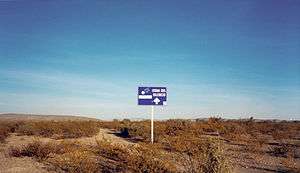Mapimí Silent Zone
| Zone of Silence | |
|---|---|
| |
 | |
| Type | l |
| Location | Mapimí Biosphere Reserve, Mexico |
| Coordinates | Maps 26°41′29″N 103°44′44″W / 26.69139°N 103.74556°WCoordinates: Maps 26°41′29″N 103°44′44″W / 26.69139°N 103.74556°W |
| Operated by | Municipality of Mapimí |
The Mapimí Silent Zone (Spanish: La Zona del Silencio) is the popular name for a desert patch near the Bolsón de Mapimí in Durango, Mexico, overlapping the Mapimí Biosphere Reserve. It is the subject of an urban myth that claims it is an area where radio signals and any type of communications cannot be received.[1][2]
History
Scientists have dubbed this area as the "Mar de Tetys", or the Sea of Thetys, because this area was once completely submerged in water. This is evidenced by traces of marine life fossils found in the area.[3]
In July 1970, an Athena test missile launched from a U.S. military base near Green River, Utah toward White Sands Missile Range lost control and fell in the Mapimí Desert region. When the rocket went off course, it was carrying two small containers of cobalt 57, a radioactive element.[4][5]
After several weeks of searching, local farmers found and reported the crash in the Northeast corner of the State of Durango. Once the rocket was found, a road was built, and the missile wreckage and a small amount of contaminated top soil was transported away.[3]
Legends
As a result of the US Air Force recovery operation there, a number of myths and legends relating to the area arose. Reportedly, a local resident hired to guard the crash debris during recovery operations helped spread these rumors. Legends include "strange magnetic anomalies that prevent radio transmission", mutations of flora and fauna, extraterrestrial visitations,[1][2] and a Mexican pilot who supposedly first reported that his radio experienced unexplained malfunctions while flying over the area in the 1930s.[3] The area is sometimes compared to the Bermuda Triangle, as both are located between parallels 26 and 28.[3]
However, when compasses and communications equipment are shown to work properly in the zone, local new age and paranormal enthusiasts claim that "the zone moves around". Residents, who do not accept the zone's existence, call such enthusiasts "zoneros" or "silenciosos", and say their activities have an adverse effect on the region.[6] Nonetheless, the legend is now being used to help promote tourism in the region.[7]
See also
References
- 1 2 Eckles, Jim. "The Athena That Got Away". White Sands Missile Range. Retrieved 21 February 2011.
- 1 2 Kaus, Andrea. "The Zone Of Silence of northern Mexico - scientific marvel or just fiction?". MexConnect. Retrieved 21 February 2011.
- 1 2 3 4 “Mapimi Silent Zone.” Atlas Obscura, Web. Accessed 13 December 2017.
- ↑ Associated Press (August 4, 1970). "Mexicans Find Radioactive Cone". The Milwaukee Sentinel. Retrieved July 27, 2015 – via Google News.
- ↑ Associated Press (August 4, 1970). "Mexicans Find Errant Rocket". The Toledo Blade. Retrieved July 27, 2015 – via Google News.
- ↑ Mapimí Silent Zone - Atlas Obscura
- ↑ Wilson, T.E. "Exploring Mexico's Zone of Silence, Where Radio Signals Fail and Meteorites Crash". atlasobscura.com. Retrieved 2018-04-24.
Further reading
- Guia Roji, México Tourist Atlas 2002, p. 70. ISBN 970-621-176-4.
- Zona del Silencio and its Legend